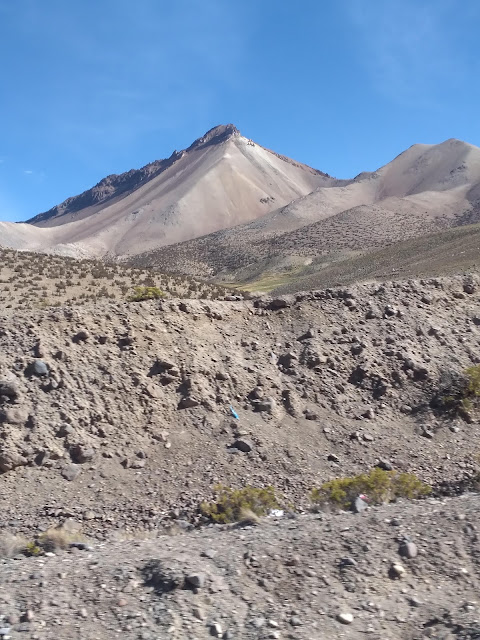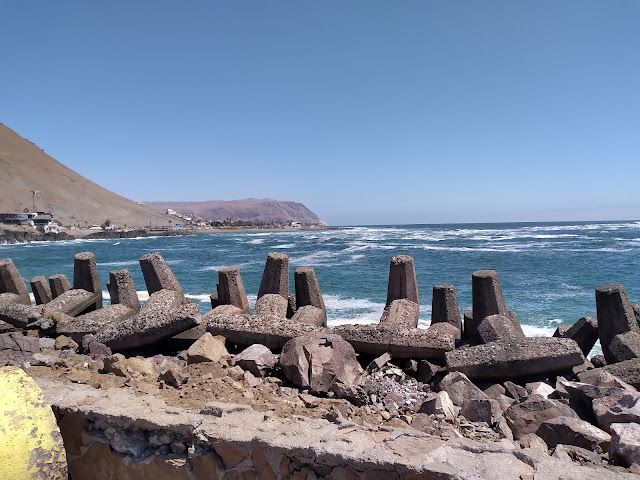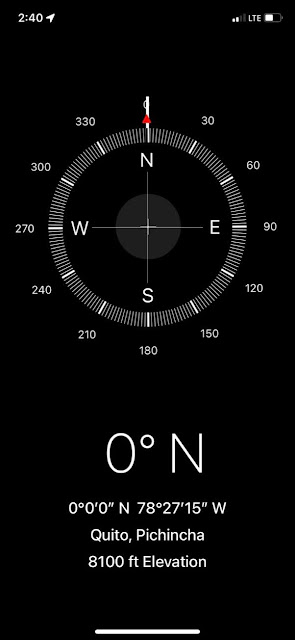It Would Be Better If We Could Breathe in La Paz
One of the joys of travel in La Paz is on the cable car system known as the Teleférico. If you travel in the middle of the workday, the cars are not crowded, the cost is 45 cents per section, and you trip along in total silence....way up there, staring into the windows and patios of other people's' private lives.
Here we are headed up to El Alto, once the second largest city in Bolivia, now swallowed up by La Paz. 99% Indigenous Quechua and Aymara, elevation of 13,620 and a view of Illimani at 21,122 feet in the distance, the Guardian of La Paz with its many glaciers now almost gone.
The city of La Paz is built on unconsolidated glacial deposits from the last Ice Age. The Choqueyapu River cuts a steep canyon through these glacial sediments, where the city is built. What do high rainfall, unconsolidated sediments and steep slopes produce? Common disastrous landslides.
If you catch the Green Line all the way to the end and then take a short taxi ride you can reach Valla de La Luna.
It is said that Neil Armstrong named this enigmatic place the Valley of the Moon because of the great resemblance to formations he had seen on the moon. It didn't take long for the Bolivian Tourist Agency to adopt the name.
On the other side of the Valley, amongst those green trees is the La Paz Golf Club At 11,800 feet, it is the highest tournament standard golf course in the world.I took the picture because of the gentleman standing on one of the pinnacles was playing one of those pan flutes. The San Pedro Cactus, chocked full of Mescaline, grows abundantly in these parts and I read that they close the park at 4:00 PM because people were eating the cacti, tripping balls and wandering off into a movie that didn't end well. How he got up there is anyone's hypothesis but my money says the dude flew through a cosmic portal.
I guess this is as good a place as any to have lunch.
There is a bizarre street in La Paz that houses the peculiar Witches' Market. If you are suffering from altitude sickness, are into High Andes natural medicine and hocus pocus, want to put a curse on someone, want to change your luck, liven up your love life, solve fertility or money problems and more...look no further.
I guess this is as good a place as any to have lunch.
There is a bizarre street in La Paz that houses the peculiar Witches' Market. If you are suffering from altitude sickness, are into High Andes natural medicine and hocus pocus, want to put a curse on someone, want to change your luck, liven up your love life, solve fertility or money problems and more...look no further.
The market offers spiritual advice, pagan rituals, amulets, magic potions, talismans, San Pedro hallucinogenic cacti, mummified frogs and turtles, toucan beaks, Coca leaves, medicinal herbs, all the raw ingredients for the rituals that populate the Aymara and Quechua worlds.
Dried llama fetuses, shown hanging from the rafters of the above store, are buried in the foundations of new buildings as an offering to The Earth Mother Pachamama. It is believed that the buried llama fetuses keep the construction workers safe, but these are only used by poor Bolivians. Wealthy Bolivians usually sacrifice a living llama to Pachamama.
Lilly had a shaman lady read Coca leaves to divine her future.
The shaman lady kind of freaked out when she saw me taking this picture....
but calmed down when Lilly bought these two lucky, healthy baby talismans. They are for my two sons, whose respective spouses are expecting soon. I sent this picture to them through email and will give them the real ones when we return for visitation.
The shaman lady kind of freaked out when she saw me taking this picture....
but calmed down when Lilly bought these two lucky, healthy baby talismans. They are for my two sons, whose respective spouses are expecting soon. I sent this picture to them through email and will give them the real ones when we return for visitation.
(Nothing like a little cashola to calm down a pissed off Quechan shaman lady).
This is the clock tower in the building that houses the Bolivia's Legislative Assembly in central La Paz. Notice how the face of the clock is a mirror image of a regular clock?
This is the clock tower in the building that houses the Bolivia's Legislative Assembly in central La Paz. Notice how the face of the clock is a mirror image of a regular clock?
The numbers on the face of the clock are reversed and the clock itself runs counterclockwise.
In 2014, Bolivian Foreign Minister David Choquehuanca thought that this was a good idea, much to the bewilderment of the tourists and office workers below. "Who said clocks have to run the same way? Why do we always have to be obedient?" he pondered.
Choquehuanca had a couple of reasons: 1) Bolivia's two main Indigenous groups, the Quechua and the Aymaran view the past in front of them and the future behind them. 2) Modern clocks evolved from ancient sundials. In the Northern Hemisphere the shadows of a sundial run clockwise. In the Southern Hemisphere, counterclockwise (NOT SO FAST! This is not true for the entire year. Being close to the Equator, the shadows on the Bolivian sundial change to clockwise for several months in the summertime, but I digress).
Hence, "the Clock of the South"
San Pedro Prison is located incongruously right smack dab in the middle of La Paz. The prison was built to hold 600 inmates and now holds 3000 (including the women and children that live there with their convicted husbands and guests staying at the prison hotel).
It is renown for being a self governing society within itself. The guards do not enter the prison. All inmates have some job, hustle or business inside or they are high rollers and bring money from the outside; either way they must pay for everything. Like on the outside, the more money you have, the nicer the accommodation.
There are "neighborhoods" within San Pedro, the higher end ones being like gated communities. "La Posta" is the nicest 'hood, boasting a hot tub and three floors of luxury cells. The poorest inmates, often drug addicted, live in cramped conditions, five to a one man cell, where most of the night time stabbings occur.
There is an unusual amount of freedom in the prison (until there is not). Elected leaders enforce the laws of the community, usually through stabbings. There are restaurants, canteens, billiards, poker, chess and video rental. Child molesters and rapists receive a rude welcome upon arrival. Many are beaten and drowned in a pool in the middle of the court yard; those that survive must pay for the services of the prison hospital.
Word has it that the finest cocaine in Bolivia is produced in San Pedro laboratories and a large amount is shipped overseas. Drug use is heavy and addict inmates set up crude processing systems to use the by-products from the quality labs.
The the guards are outnumbered 2000 to 20 and have little authority; that coupled with living in a poverty stricken country makes the guards especially vulnerable to bribery. Inmates have to pay the guards to: enter the prison, possibly pay the guards to have a trial, have family, tourists and prostitutes visit, overlook the cocaine trade, the prison tours and virtually everything else.
Which leads us to the fact that it has been almost 25 years since San Pedro became a tourist destination (and was mentioned in the Lonely Planet Guidebook "Things to Do in La Paz Section), where some backpackers stayed for weeks bingeing on some of the best blow in the world for pennies on the dollar.
It started in 1996 when one Thomas McFadden, evidently a charismatic English-Tanzanian was busted in the La Paz airport with 5 kilos of Bolivian flake and found himself jailed in a place more like a warped small town than a prison.
The enterprising McFadden bribed the guards and at his peak, was giving tours to 70 tourists a day, providing income to convicts and guards alike. For an extra fee, intrepid travellers could spend the night, week or month and party with the inmates. Word got out in the hostels along the gringo trail and business boomed.
A curious young Aussie named Rusty Young bribed his way into San Pedro and was McFadden's cell mate for a few months. In 2003, he wrote about the experience in the book Marching Powder which became widely read in some circles. The popularity of the book brought movie offers and documentaries; the nascent Internet picked up on it, international outrage ensued and the Bolivian Government (supposedly) ended the tours in 2008.
More paradoxical images as we ate in this Italian restaurant, just across the plaza from the prison. Could have been in Italy somewhere.
Waiting line for visitors at San Pedro's Main Entrance. Wonder what kind of contraband was going in and coming out of there today?The bus station in La Paz, built in 1917 and engineered by Alexandre Gustave Eiffel. Recognize the name? Yup, same dude.
Going to catch the bus here and head out of the mountains and down to the sea level beach town of Arica, Chile. I know Lilly is going to love that. We both never really knew how much we liked oxygen.
That concludes our month in La Paz. We just kind of lived and hung out in Paz and did not take the any of the many day trips that are available out in the boondocks, due mainly to the altitude and the bad roads out of here.
Just weren't up for the rigors of it.
La Paz has a large modern Indigenous culture and fewer of the corrupting tourists that one sees in say Peru. It was interesting to see large numbers of them leading modern lives in their bad-ass bowler hats with one foot in the past, albeit at the very bottom of the modern economic scale. Plenty of breathtaking vistas to see, plenty of wacky, strange and interesting things to do around our neighborhood in La Paz.
It would have been been better if we could have breathed a little better and didn't have to climb Mount Everest everytime we went to the store.
The luxury bus left La Paz and passed through the epic Lauca National Park. Antiplano, glacial debris, majestic volcanos, marshes, alpine lakes, llamas, alpacas and wild vicuñas.
Volcanoes Pomerape and Parinacota at 20,800. Two of many in a volcanic chain. The Tambo Quemado-Chungara pass marks the Chile-Bolivia border and our highpoint in the Andes. For the next six hours we are headed downhill!
The old railway station in Arica, before people switched to buses.
Andean sediment headlands and palm trees.
Where the Atacama Desert meets the Pacific Ocean. Some meteorological stations have never recorded one drop of rain in parts of the Atacama. Be that as it may, we are happy with the elevation: ~6 feet.
Thanks for stopping by.jpg)



























Comments